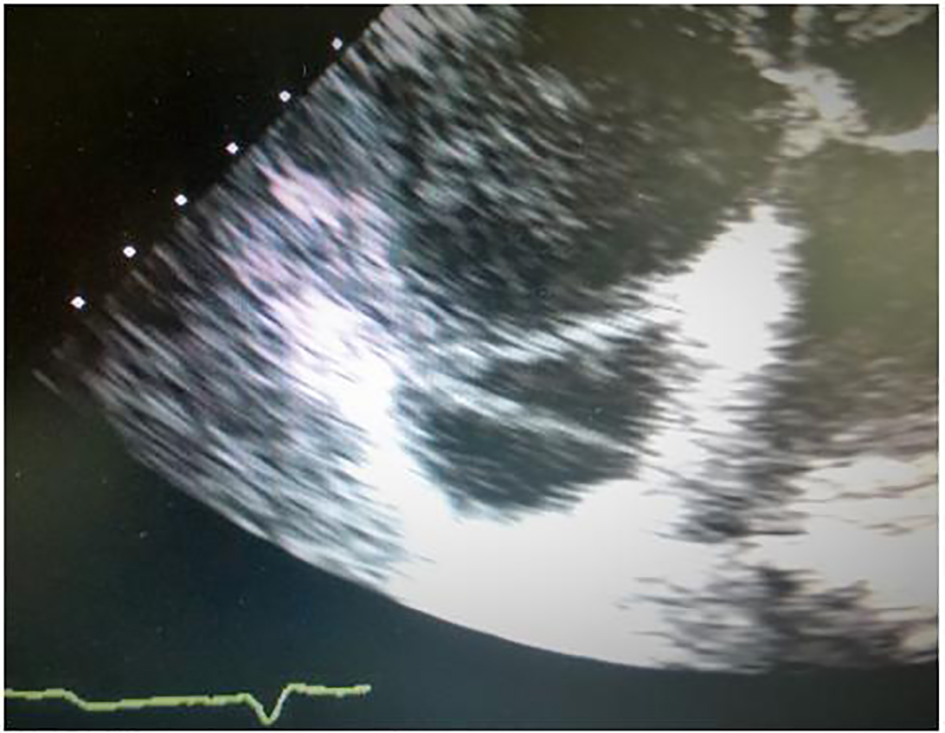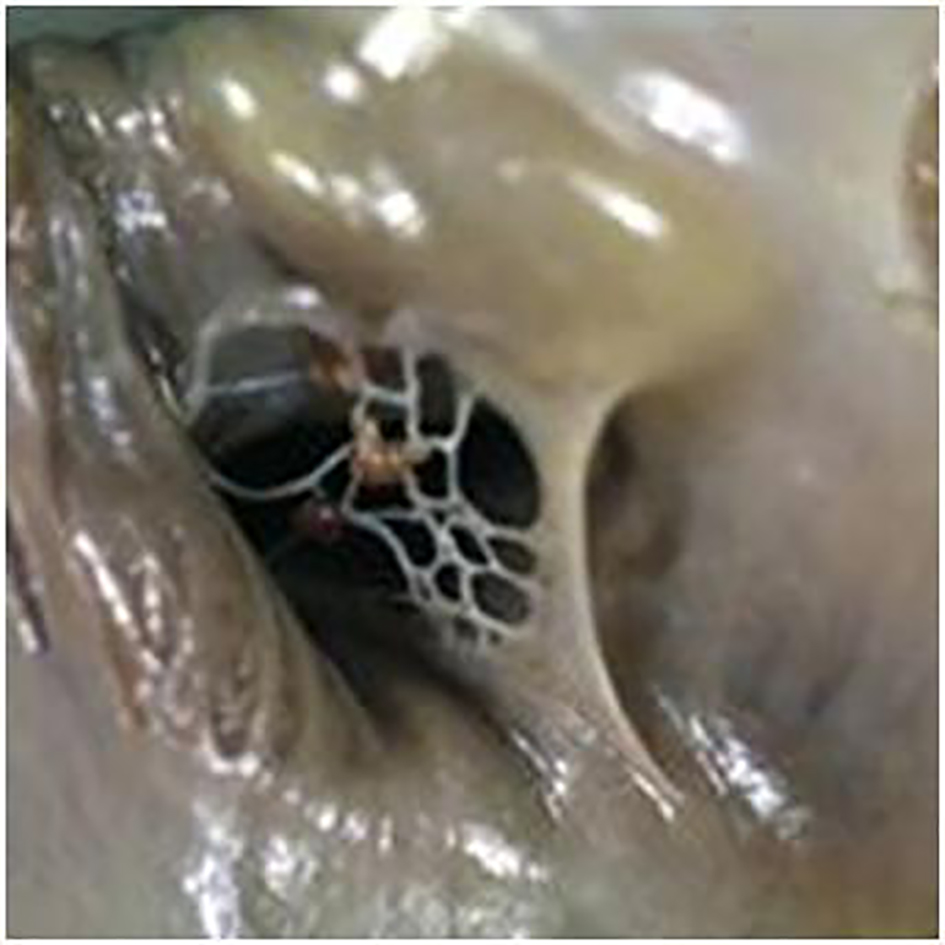| Journal of Medical Cases, ISSN 1923-4155 print, 1923-4163 online, Open Access |
| Article copyright, the authors; Journal compilation copyright, J Med Cases and Elmer Press Inc |
| Journal website http://www.journalmc.org |
Case Report
Volume 7, Number 7, July 2016, pages 291-293
Detecting Chiari Network in Patients to Avoid Procedural Complications
Sabrina Arsheda, c, Mohamed M. Osmana, Shilpi Singha, John Webbb, Mark Niemieraa, Shuvendu Sena, Abdulla Yousifa
aRaritan Bay Medical Center, Perth Amboy, NJ, USA
bRoss Medical University, Miramar, FL, USA
cCorresponding Author: Sabrina Arshed, Raritan Bay Medical Center, Perth Amboy, NJ, USA
Manuscript accepted for publication January 29, 2016
Short title: Detecting Chiari Network
doi: http://dx.doi.org/10.14740/jmc2424w
| Abstract | ▴Top |
Chiari networks are remnants of embryologic structures whose incomplete involution creates a net-like membrane in the right atrium. When discovered it is normally of little clinical significance and is found in 2-10% of the population. Nevertheless, there are reported cases of this formation having causation in atrial arrhythmias, thrombus formation, tumor development, tricuspid regurgitation, embolus and catheter entrapment/entanglement during invasive procedures. We present a case of a patient with an incidental finding of Chiari network on echocardiography and discuss the importance of detecting these formations before certain cardiac procedures.
Keywords: Cardiac; Procedures; Chiari network; Catheterization; Echocardiography; Complications
| Introduction | ▴Top |
Chiari network is an uncommon finding, yet may play a significant role in cases that require intrusion into the right atrium. Assessment of normal structures and exclusion of abnormal findings are crucial before intra-cardiac procedures. Echocardiographically, a Chiari network formation appears commonly as a highly mobile whip-like structure in the right atrium which could easily be confused for thrombus formation or valve vegetation. 3D transthoracic echo has been shown to have an increased role in differentiating these findings.
Entanglement of catheter devices in the Chiari network is a serious concern and can increase the complexity of procedures. Potential consequences include breaking of the net-like structure initiating an embolus or prolapsing structure into the tricuspid valve causing regurgitation. Local insult and abrasion via catheter introduction could lead to increased risk of thrombus formation or altered electrical activity leading to dysrhythmia. Catheters, guide wires and pacemaker leads have the potential to damage or get entangled in both identified and unidentified Chiari network. Discovering the existence of this abnormal structure pre-procedurally may alter the course of diagnostics or treatment, and allows the medical team to have a heightened sense of awareness during any given procedure.
| Case Report | ▴Top |
A 92-year-old female was admitted to the hospital for congestive heart failure decompensation. She had a past medical history of type II diabetes mellitus, hypertension, coronary artery disease with stent placement, peripheral vascular disease with femoral artery embolectomy, history of DVT, pacemaker placement, atrial fibrillation, seizures, and dementia. Upon initial examination, her blood pressure was 116/60 mm Hg, pulse was 90 and irregular, respiration was 16, O2 saturation was 95% on 2 L nasal cannula, and was afebrile.
Echocardiogram demonstrated an abnormal whip-like structure in the right atrium consistent with a Chiari network (Fig. 1). Additional echo findings were mildly calcified aortic valve with regurgitation, moderate left ventricular hypertrophy with mild dilation, mitral calcification, thickening, and mild regurgitation. Also present was moderate to severe tricuspid valve regurgitation, and severe pulmonary hypertension that was estimated to be > 60 mm Hg. As this patient was identified as a candidate for cardiac catheterization (right and left), we were subsequently compelled to inform the cardiac team of the prominent presence of the network.
 Click for large image | Figure 1. Echocardiographic image of the right atrium, demonstrating Chiari network as the lower echogenic shadow, as well the pacing wire is also demonstrated on top. |
| Discussion | ▴Top |
In weeks 3 - 8 of embryological development, the sinus venosus and atrium undergo a plethora of changes with the eventual involution of one communicating side of the sinus venosus [1-3]. However, as first described by pathologist Hans Chiari in 1897, a remnant of this sinus venosus can persist in the right atrium [4]. Its configuration and size can vary with a net-like structure being the most described arrangement (Fig. 2). Prevalence of this abnormality has been reported from 2% to as high as 10% in various studies and is usually incidentally found [2-4].
 Click for large image | Figure 2. Gross pathology image of Chiari network, close-up of coronary sinus with fenestrae in valve. Image courtesy of Professor Peter Anderson DVM PhD and published with permission © PEIR, University of Alabama at Birmingham, Department of Pathology. |
A few studies have postulated that this fenestrated net may act as a filter for thrombus formation entering into the right atrium [3, 5]. However, other studies have demonstrated trapped thrombi forming a complex within the Chiari network which can be refractory to thrombolytic therapy [6]. Additionally, further studies have suggested that the web of the formation could actually encourage new thrombus creation [2, 3, 7]. To date, there is no surgical indication to remove an asymptomatic Chiari network.
Previous case reports have described massive right atrial thrombus formed on a Chiari network, leading to intermittent tricuspid obstruction [5]. In one report thrombus had formed after the use of a Hickman catheter for the administration of cytotoxic chemotherapy [5]. Another case reports cardiac catheterization in a 51-year-old man with secundum atrial septal defect, and catheter entrapment within the area of the inter-atrial defect [6]. At thoracotomy, the catheter was found to be caught by and looped within a Chiari network involving the septal defect, a hitherto unreported complication of cardiac catheterization [6, 8]. A guide wire having been entrapped by the Chiari network prior to an intended radiofrequency ablation procedure has also been reported [6, 8].
Conclusion
Central venous catheters (especially right atrial catheters) for large bore access or venous sampling, right heart pressure catheters, ablation catheters, invasive electrophysiological study catheters and internal cardiac cardioversion catheters are frequently utilized in the hospital setting. Procedures deploying these devices present their own set of risks without anatomic abnormalities. When considering inserting and removing guide wires, sheaths, and other parts of intra-cardiac catheters, the threat of getting entangled within the varied construct of a Chiari network is high. Therefore, careful pre-procedural echocardiographic evaluation is paramount in mitigating potential adverse effects of cardiac-based procedures which may occur as a result of this not uncommon finding.
Financial Support
No financial support was provided for this publication.
| References | ▴Top |
- Poanta L, Albu A, Fodor D. Chiari network - case report and brief literature review. Med Ultrason. 2010;12(1):71-72.
pubmed - Schneider B, Hofmann T, Justen MH, Meinertz T. Chiari's network: normal anatomic variant or risk factor for arterial embolic events? J Am Coll Cardiol. 1995;26(1):203-210.
doi - Islam AK, Sayami LA, Zaman S. Chiari network: A case report and brief overview. J Saudi Heart Assoc. 2013;25(3):225-229.
doi pubmed - Bae CH, Kwon OC, Lee S, Lee CH, Cho JW. Cystic Mass on Right Atrium of Unusual Form of Chiari's Network: A Case Report. Korean J Thorac Cardiovasc Surg. 2012;45(4):254-256.
doi pubmed - Benbow EW, Love EM, Love HG, MacCallum PK. Massive right atrial thrombus associated with a Chiari network and a Hickman catheter. Am J Clin Pathol. 1987;88(2):243-248.
doi pubmed - Goldschlager A, Goldschlager N, Brewster H, Kaplan J. Catheter entrapment in a Chiari network involving an atrial septal defect. Chest. 1972;62(3):345-346.
doi pubmed - Bhatnagar KP, Nettleton GS, Campbell FR, Wagner CE, Kuwabara N, Muresian H. Chiari anomalies in the human right atrium. Clin Anat. 2006;19(6):510-516.
doi pubmed - Motovska Z, Widimsky P, Bilkova D, Penicka M, Linkova H, Kautznerova D, Kolesar M, et al. An embolus in the right atrium caught in the Chiari network and resistant to thrombolysis. J Thromb Thrombolysis. 2010;30(1):114-118.
doi pubmed
This is an open-access article distributed under the terms of the Creative Commons Attribution-NonCommercial 4.0 International License, which permits unrestricted non-commercial use, distribution, and reproduction in any medium, provided the original work is properly cited.
Journal of Medical Cases is published by Elmer Press Inc.


